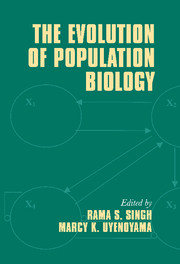Book contents
- Frontmatter
- Contents
- List of contributors
- Publications of R. C. Lewontin
- Preface
- Introduction
- Part I Historical foundations and perspectives
- 1 Building a science of population biology
- 2 Toward a population biology, still
- Part II Genotypes to phenotypes: new genetic and bioinformatic advances
- Part III Phenotypes to fitness: genetics and ecology of populations
- Part IV Genes, organisms, and environment: evolutionary case studies
- Part V Applied population biology: biodiversity and food, disease, and health
- Index
1 - Building a science of population biology
Published online by Cambridge University Press: 08 January 2010
- Frontmatter
- Contents
- List of contributors
- Publications of R. C. Lewontin
- Preface
- Introduction
- Part I Historical foundations and perspectives
- 1 Building a science of population biology
- 2 Toward a population biology, still
- Part II Genotypes to phenotypes: new genetic and bioinformatic advances
- Part III Phenotypes to fitness: genetics and ecology of populations
- Part IV Genes, organisms, and environment: evolutionary case studies
- Part V Applied population biology: biodiversity and food, disease, and health
- Index
Summary
There has long been a distinction made by biologists between those phenomena and explanations that are at the level of individual organisms and their constituent parts, and those that are at the level of populations. Developments in individual-level biology are almost entirely motivated by prior empirical discoveries, despite efforts, largely unsuccessful, to create a mathematical basis for molecular, cellular, and physiological events. In contrast, the investigation of population level phenomena has been almost entirely theory driven. Models have been created of population-level phenomena which are then represented as mathematical structures, with specific functional forms, variables, and parameters. Empirical work is, at the very least, informed by these models or, more often, is designed to measure the variables and estimate the parameters of a specific model, or to test whether a particular model is an adequate representation of the natural process. That does not mean that the structures of models are not reciprocally informed by empirical findings. In some cases discoveries of new phenomena at the individual level may require the enrichment of the variety of population models, as for example when the discovery of non-Mendelian segregation patterns such as t-alleles in mice (Dunn 1957) and segregation distorters in Drosophila (Sandler et al. 1959) required the inclusion of the segregation ratio in gamete pools of heterozygotes as a parameter to be empirically determined.
- Type
- Chapter
- Information
- The Evolution of Population Biology , pp. 7 - 20Publisher: Cambridge University PressPrint publication year: 2004
- 2
- Cited by



